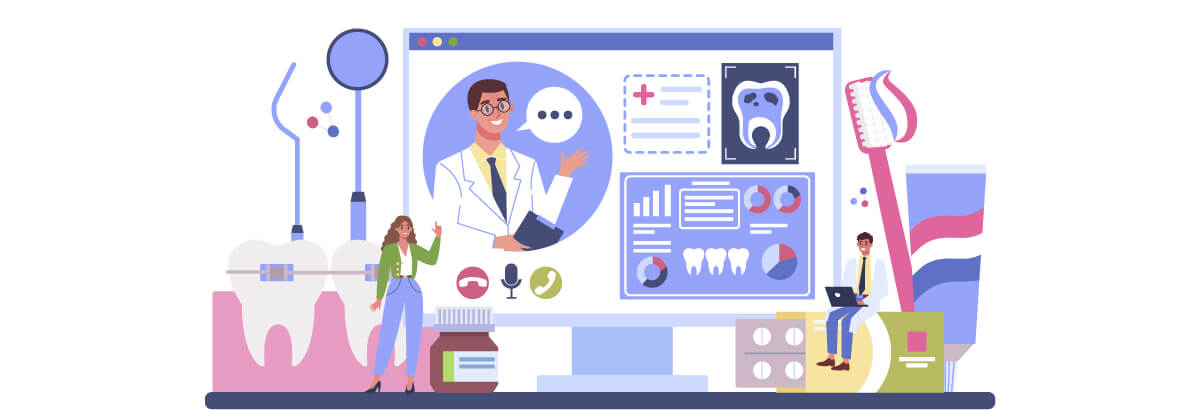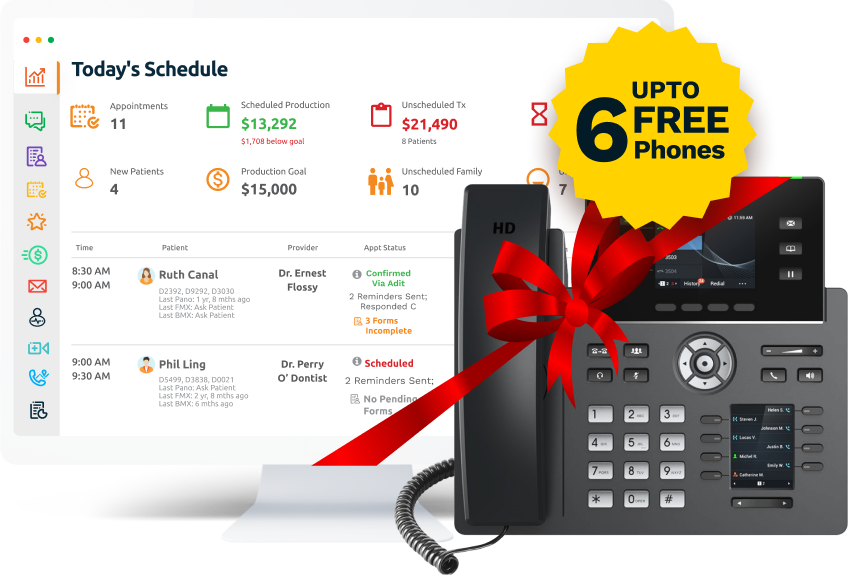Ends in
ends in 128 Days

ends in 128 Days

ends 11 July
Teledentistry Codes and Billing for Remote Care

Teledentistry has become more and more the norm around the country because of COVID-19. However, it's still imperative to understand what dental insurance companies will or will not bill for teledentistry services.
In teledentistry, Current Dental Terminology (CDT) codes are required when requesting reimbursement from insurers. These abbreviated numbers and letters provide a standardized set of coded descriptors for reporting your services to dental insurers.
Ensuring your practice has a solid grasp of this coding will minimize denials and delays in payment for the procedures you provide.
This article provides a quick overview of important teledentistry coding and billing as well as some best practices for avoiding delayed and denied reimbursement requests.
Teledentistry Coding and Billing

There are two specific types of coding your team needs to be familiar with to ensure payment gets received: synchronous and asynchronous. Synchronous code describes a real-time consultation/treatment (ex: Facetime dentistry), with you and the client speaking directly with one another. Asynchronous CDTs involve patients submitting information to their dentists who then review these details later and send a response. This process doesn't happen in real-time.
Step one in dental coding is deciding whether the treatment is synchronous or asynchronous. Next, choose a teledentistry code and an oral evaluation and case management code. Be mindful that an insurer may treat these as administrative, but this is not always the case. Sometimes, a carrier may be willing to adjust their policy to reimburse your office.
Check out the quick overview below of the most frequently used billing codes for teledental services:
Teledental Visit Codes

D9995
This is a synchronous CDT code used to report care encounters that occur in real-time and related procedures provided on the day of service.
D9996
Use this asynchronous code for dental services where information gets submitted to a dentist for review and reply without a face-to-face consult. This and other performed services can be reported together on the same service date.
Codes for Dental Evaluations

D0140
Growing without the pains: Granite Bay Pediatric Dentistry's 4X revenue growth in 2.5 years with Adit Are you a new dental practice or startup? Granite Bay Pediatric Dentistry’s rapid success is rare in the dental industry but common among...
Schedule a DemoYour team would use this code as it relates to a specific oral health problem and evaluation. It's important to always include information from related diagnostic procedures to assist in understanding the need for any treatment and diagnosis.
D0170
Use this code for dental treatments involving a pre-existing condition requiring an assessment to determine its current status. Typically, your billing department would use this if a patient is coming in for a follow-up as part of their ongoing care.
D0171
Procedures using this code are usually part of post-operative care and follow-up evaluations of the patient's recovery. This could involve simply deciding if further care is necessary by the dentist or assessing how well the healing process is going.
Case Management Coding

D9991
As a dentist, you may have patients who are unable to receive care due to transportation issues. This code is applicable when your dental office assists a patient in getting transport to and from scheduled appointments.
D9992
As a dental provider, there are times when your patients need your assistance in coordinating their oral healthcare needs. This code represents the additional effort, time, and resources your office provided to assist them. For example, if your young dental patient needs a maxillofacial surgeon for corrective palate surgery, your team would help their parents coordinate this care with your office.
D9993
This code represents Motivational Interviewing (MI) which your office provides a patient with personalized counseling to help them modify harmful behaviors directly impacting their oral health.
D9994
Sometimes, your team will need to take a more personalized approach to motivate a patient to improve their oral healthcare. This may require educating them on how to make better health decisions that address the difference in cultural beliefs or through different language preferences that go beyond the typical case presentation or dental evaluation.
Top Reasons Dental Claims Get Denied

Denials of dental claims can have a terrible impact on both the dentist and the patient, so getting early verification can prevent nagging claim denials. This process of checking a client’s eligibility before they sit in your chair ensures they have eligible, active benefits and coverage and will reap lots of monetary rewards.
If you understand why claims get denied you can prevent them. Check out the most frequent causes for claim denials below:
Incomplete Claim Information

Lack of information accounts for nearly half of all dental claim denials. This could partly be attributed to the need for the varying CDT-codes narrative requirements to process a reimbursement request.
Not counting the specifics of the ‘5 W’s’ (who, what, when, where, and why) that support the claim, the information provided must clearly explain the procedure performed and its necessity. For instance, if you’ve been doing periodontal charting on a patient, include treatment history with the claim and any films taken over the past six months.
Coverage Limitations
Exclusions, capped limits, and treatment frequencies are trappings that all come with dental plans. These same plans set a policy maximum on how much gets paid for care based on a yearly and sometimes lifetime calendar. Plans might also contain frequency limitations, which means that a patient can only receive certain dental procedures a few times a year, so additional instances won't be covered.
Because of these plan limits, before you provide any treatments, your team needs to verify all benefits so that all caps, exclusions, and frequencies are known. Procedures with a higher price tag should get pre-authorized first to avoid any surprises when billing the patient later.
Late Claim Filing

Each health insurance provider has its own set of deadlines for filing claims. If your submissions are outside of that deadline, then your office might receive a denial. Always submit your dental claims as soon as the procedure is complete. Keep in mind that grace periods for submission can range greatly. Some policies have a one-year time limit, while others are much short at only 180 days or less.
Information Errors
One of the most common mistakes that can cause a claim denial is data entry errors. When your team updates patient dental records, using the wrong procedure code, incorrect treatment dates, and simply misspelling the patient's name, can lead to denied reimbursements.
If your practice still relies on manually adding data to your EHR, this problem will persist. Using modern practice management software like Adit can automate much of this issue and create a more uniform and accurate approach to your claims process.
Insurance Details are Not Up-To-Date

Patients rarely understand how their benefits work and often have no idea what their limits are or that coverages have changed. This ignorance can be a source of frustration when your office bills for dental services and later get denied because of a policy update from earlier in the year.
Avoid claim denials and upset patients by electronically verifying insurance eligibility and coverages as soon as possible. When scheduling appointments, include a reminder to submit this information before the visit date. This allows your team to address any issues ahead of time and allow your patients time to correct them or arrange other means to receive their care.
Coordination of Benefits (COB) Issues
It's not uncommon for patients to have multiple dental insurance plans to cover their care. When this occurs, a Coordination of Benefits (COB) takes place. To avoid delayed payment, all claim information must be accurate and complete. A common scenario that leads to denials and slow pays is failing to include an Explanation of Benefits (EOB) from the patient's primary insurance when requesting payment from their secondary coverage.
Always confirm whether someone has primary and secondary insurance at every visit.
Your Team Didn't Receive Pre-Authorization
Prior authorization is often mandatory for dental treatments involving oral or reconstructive surgery. Not obtaining this authorization will lead to the denial of payment. Providers should know in advance which insurers will require prior authorization and for which procedures. Predeterminations on costly and complex procedures should be obtained as close to the proposed treatment date as possible.
Winning the game with dental insurance means practices must educate parents about their coverage. Below are some strategies to help with this task:
- Pass out brochures explaining dental insurance in a language that anyone can understand. People need to know what is usually covered or not covered and how copays work.
- Have a heart-to-heart chat with patients to help them understand the facts of dental insurance.
- Make sure to communicate your practice policy on collecting copays.
Processing insurance for teledentistry can be problematic. Remember, teledentistry is often considered an administrative cost and won’t always be reimbursed. That said, the ADA recommends that dentists report every cost related to services coupled with a virtual visit.
According to the ADA, you should consider charging for all the elements involved in a teledentistry visit, including technology for sharing needed health information between your office and the patient. However, it's critical to determine whether your state allows you to do so. Many restrictions around teledental billing were relaxed throughout the country after the pandemic, but in some regions of the U.S., this was only a temporary measure.
Teledentistry Billing Doesn't Have to Be Difficult

With the telemed and teledentistry industry booming, billing has become more complex, creating a greater risk of error and resulting claim denials. If your team struggles with accurately coding services and procedures, and your current practice management software doesn't offer CDT updates, this process can quickly become a costly, uphill battle.
As your dental office begins taking a modernized approach to oral healthcare and access, your billing software should be up to the task. Cloud-based PMS platforms have revolutionized and improved the claims reimbursement process so that submitted requests are accurate, timely, and contain all the necessary information to get approvals sooner.
For example, Adit Pay can provide you with an end-to-end teledentistry software billing solution that ensures your team has the most up-to-date CDT list to choose from with just the click of a button. Say goodbye to the three-ring circus event that your end-of-month billing and reimbursement cycle has become! Adit helps busy dental practices like your own create an efficient invoicing process thanks to our over 15 digital management tools and advanced automated features.
Our easy-to-use platform and integrations help your practice turn into a dental organization that is tech-forward, efficient, and profitable. Adit makes it possible to receive updates on a patient’s eligibility, benefit coverage limits, and more before their visit. This gives your team a firmer grasp of collection and reimbursement best practices and boosts your revenue for the month thanks to our built-in request monitoring. Better treatment plan preparation and reduced insurance denials can be your norm if you get ahead of potential claim issues and verify patient eligibility before they even walk through your door.
Even better? Our software easily integrates with the most popular PMS systems and streamlines your team's workload by automating appointment reminders, online scheduling, insurance pre-authorization, and so much more.
Streamline Your Teledental Billing Process with Adit
Going the extra mile to ensure patients get the most out of their insurance coverage requires your dental office to have a system that assists your team in processing claims quickly and accurately. Adit's billing software is the perfect solution with our innovative and intuitive invoicing and claims submission features. When combined with our 15+ practice management tools, frustrating reimbursement delays get reduced and often completed faster thanks to our convenient database of teledentistry CDT codes and hassle-free billing process.
Because our platform seamlessly integrates with your EHR, your dental practice can reach a new level of efficiency and profitability with your teledental services. Adit Pay also adds next-level payment flexibility for your patients, making it more convenient for patients to settle up their accounts from their favorite smart device, patient portal, or online processing site.
Contact our team today to learn more about our advanced billing module Adit Pay, and see our platform in action with a free demo.
more about Adit?
Access a full suite of patient communication tools with Adit! Texting, payments, reviews, & scheduling in one place.
Schedule a DemoAfter spending 10 years helping dentists grow their practices, Ali witnessed the time and money dentists were wasting on outdated, fragmented technology that negatively impacted sustainable growth and the overall patient experience. So he developed Adit - a user-friendly SaaS platform that centralizes everything a practice needs to operate and simplifies the business of dentistry so doctors can get back to the medicine.
Get a $25 Gift Card when you take a demo
Schedule a Demo
Get a $50 Gift Card
when you take a demo
Looks like you're out of bounds!
Hey there! Your current location falls outside Adit's area of operation. If this is unexpected, try disabling your VPN and refresh your page. For further assistance or to book a live demo, connect with us at 832-225-8865.
January 8 Amazon Demo Promo
Terms and Conditions
Last Updated: January 8, 2026Offer ends January 11, 2026, and is limited to prospective customers who sign an annual agreement before January 31, 2026. Gift card will be emailed to the company owner or established representative within 4 weeks of signing the annual agreement. Offer may not be combined with any other offers and is limited to one (1) gift card per office. Offer is not available to current customers or to prospective customers or individuals that have participated in a Adit demo during the prior six (6) months. Recipient is responsible for all taxes and fees associated with receipt and/or use of the gift card as well as reporting the receipt of the gift card as required under applicable federal and state laws. Adit is not responsible for and will not replace the gift card if it is lost or damaged, is not used within any applicable timeframe, or is misused by the recipient. Adit is not responsible for any injury or damage to persons or property which may be caused, directly or indirectly, in whole or in part, from the recipient’s participation in the promotion or receipt or use of the gift card. Recipient agrees to indemnify, defend and hold harmless Adit from and against any and all claims, expenses, and liabilities (including reasonable attorney’s fees) arising out of or relating to a recipient’s participation in the promotion and/or recipient’s acceptance, use or misuse of the gift card. This offer is sponsored by Adit Communications, Inc. and is in no way sponsored, endorsed or administered by, or associated with Amazon.
Thank You!
We appreciate your interest! Adit AI will be calling you in the next few minutes!
Why Adit?
Cut your software bill by up to 60% when you merge everything your dental office needs to run under one roof.
Centralize Communications
- Phones & TeleMed
- Emails & eFax
- Texting & Reminders
- Call Tracking and more!
Streamline Operations
- Patient Forms
- Online Scheduling
- Payments
- Reviews and more!
Boost Production
- Performance Dashboards
- Morning Huddle
- Claims & Collections
- Patient Profiles
- Follow Up Lists
- Year Over Year Metrics
Acquire More Patients
- Digital Marketing
- Website Design
- SEO
- Google Ads
- Facebook Ads
Ends in

and Get Free Phones for Life
Sign up by filling out the form







